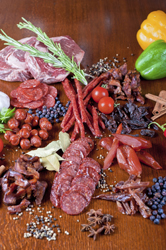Rapid meat cooling
Health regulations in the EU stipulate that cooked meat intended for delicatessen and other commercial uses must be cooled very rapidly after cooking. The targets are challenging using current methods, the best of which (vacuum cooling) cause undesirable effects such as dryness and toughness. A previously developed cook–cool technique, called immersion vacuum cooling (IVC) was investigated to solve these problems. IVC works via vacuum-treating cooked meat together with its cooking liquid, resulting in far less drying than conventional vacuum cooling. The COOL-MEAT project, 'A novel method for improving the vacuum cooling of cooked meats', aimed to develop this IVC concept. The 8-member consortium ran for 2 years to September 2012. The project undertook the design and building of a working prototype system, based on IVC, which fulfilled industry requirements. COOL-MEAT began with consultations with the participating small and medium-sized enterprises (SMEs) to determine their requirements. The project then tested the effects of numerous IVC parameters, such as vacuum pressure and immersion level, on two meat products, hams and morcillas (a Spanish blood sausage). The experimental results yielded optimal parameters, which were used to design the COOL-MEAT system. In addition, the food quality analysis provided data necessary for subsequent microbial risk analysis testing. The next project phase involved testing the quality and safety of meat processed using the COOL-MEAT system. The tests consisted of a bacterial analysis, a juiciness test, an assessment of shelf life and a nutritional analysis. The project also examined aspects of critical system control such as cleaning. Using the research data, the project successfully designed and constructed a pre-industrial prototype for subsequent testing in a real industrial context. Testing to date shows the system delivers safe, cooled meat products as specified. The system also demonstrated numerous other selling-point advantages compared to current systems, including low rate of drying, high meat quality, cost efficiency and price. The eventual fully commercial system is expected to be highly marketable, potentially targeting a large sector. The operational prototype has been installed at the Embutidos Daza sausage factory premises in Spain for further development and validation.



